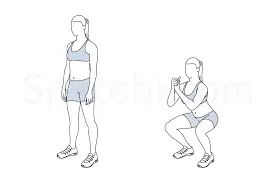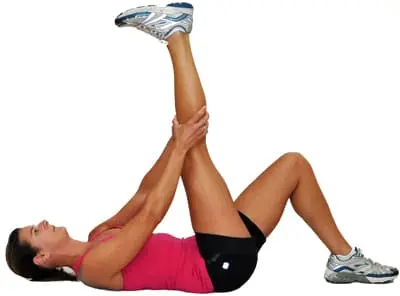Kegel Exercises
Kegel Exercise
- Exercises that entail regularly tightening and relaxing the muscles that make up the pelvic floor also referred to as the “Kegel muscles” are commonly referred to as pelvic floor exercises or Kegel exercises.
- The exercise takes one to three months to start showing results, even though it can be done numerous times a day for several minutes at a time. Strengthening the pelvic floor muscles is the goal of Kegel exercises.
- The human body uses these muscles for a wide range of purposes. They are in charge of keeping women’s bladders full, preventing vaginal and uterine prolapse, and preventing urinary stress incontinence (particularly after childbirth).
- These muscles in men are in charge of ejaculation, fecal continence, and urine continence.
- There are a number of instruments available to assist with these workouts, yet different research disagrees on how beneficial they are in comparison to more conventional activities.
- The pelvic floor muscles are the muscles you use to stop the flow of urine; strengthening these muscles can help you avoid spilling urine or inadvertently passing gas or poop.
- Both vaginal and penile sex people can benefit from doing Kegel exercises. Simple clench-and-release motions called Kegel exercises can help strengthen the muscles in your pelvic floor.
- The space between your hips that houses your reproductive organs is called your pelvis.
- The pelvic floor is actually a network of tissues and muscles that come together to form a hammock or sling at the base of your pelvis.
- Your organs are held in place with this sling. The inability to regulate your bladder or intestines is one of the problems that might result from a weak pelvic floor.
- Kegel exercises are simple to perform and may be done anywhere, at any time, even in the comfort of your own home or while standing in the queue at the bank.
What is a Kegel Exercise?
Your pelvic floor muscles can be strengthened using kegel exercises, commonly known as pelvic floor exercises. The muscles of your pelvic floor support the organs in your pelvis, including the bladder, bowel, and vagina. Your pelvic floor muscles help in sex, urination, and other body activities while also supporting the position of your organs. Kegel exercises improve your pelvic floor muscles by first tightening and then relaxing them.
Kegel exercises can assist with problems like:
- urine leakage, or incontinence.
- urge incontinence, or the sudden need to urinate.
- Defecation (leaking of feces).
- Pelvic organ prolapse refers to the sagging or bulging of the pelvic organs into the vagina.
Kegel exercises can also help you have better orgasms and enhance your sexual health. Kegel exercises are beneficial for both men and women who were designated male or female at birth (AMAB and AFAB, respectively).
What do Kegel exercises actually do?
- Your pelvic floor muscles will stay “fit” if you perform Kegel exercises. Kegel exercises are a good method to maintain the strength of your pelvic floor muscles, much as lifting weights can help build other muscles in your body.
- Kegel exercises can help you maintain stronger pelvic muscles and improve control over your bowel and bladder movements.
- It’s possible to inadvertently discharge gas or leak stool and urine due to weak pelvic floor muscles. The muscles that support your pelvic floor may decrease as you age or as a result of pregnancy, delivery, or surgery.
Who needs to do Kegels?
Anything that strains your pelvic floor muscles may weaken them and reduce their ability to support your pelvic organs. Your pelvic floor muscles may become weak due to specific medical disorders or life circumstances. Among these circumstances and occurrences are:
- maternity.
- Birthing, including cesarean sections.
- Being overweight (BMI larger than 25) or obese (body mass index, or BMI, greater than 30).
- Surgery pertaining to your pelvis.
- growing older. As you age, the muscles in your rectum, anus, and pelvic floor inevitably deteriorate.
- persistent coughing or excessive straining when passing gas (constipation).
- workouts (particularly sprinting, jumping, and lifting big weights).
Kegel exercises aren’t appropriate for everyone, though. Overdoing Kegel exercises or performing Kegels when not necessary might lead to overly tight or stiff muscles.
Pregnancy and Kegel exercises
Doing Kegel exercises while pregnant may make delivery simpler for expectant mothers. This is because, during labor and delivery, it might provide you more control over your pelvic muscles. It can also be beneficial for:
- Bladder management.
- Enhancing the fetal weight-bearing muscles’ strength.
- Leakage of urine or urinary incontinence.
- Pushing during giving birth vaginally.
- Healing of the perineal following birth.
How can I locate my muscles in my pelvic floor?
- Try stopping the flow of your urine while seated on the toilet to identify your pelvic floor muscles. Do not stop until you have a sense of how it feels; otherwise, you run the risk of becoming infected. It’s also possible to see oneself attempting to stop yourself from passing gas.
- Another option is to put your finger within your vagina and squeeze the surrounding muscles. Your finger should be under strain. The muscles that you strengthen during Kegel exercises are the same ones that you feel “lifting” when you perform these exercises.
- Comparing your pelvic floor to a claw vending machine game you may have played as a kid could be useful. In a claw machine game, a metal claw spreads apart and retracts.
- When it opens, it takes up a ball, toy, or piece of candy before shutting.
- The claw returns to its initial position and remains closed after it has closed around your reward. The way the claw closes and draws upward is almost exactly like a Kegel.
How do I perform Kegel exercises?
When you execute Kegel exercises, your pelvic floor muscles are lifted, held, and then relaxed. Begin by performing a small number of Kegels at a time, and then progressively increase the duration and quantity of Kegels performed in each “session” (or set). At least two or three sets of these exercises should be done each day.
To begin with:
- Locate the appropriate muscles. Pause mid-urination to identify your pelvic floor muscles.
- You can perform the exercises in any position once you’ve determined which muscles in your pelvic floor are involved, though initially, you may find that lying down is the most comfortable.
- Develop your method. To perform Kegel exercises, tense your pelvic muscles as though you were lifting a marble while seated.
- Try it for three counts of three seconds at a time. Then, relax for three counts.
- Keep your attention focused. For best results, focus just on engaging your pelvic floor muscles.
- Be careful not to flex the muscles in your thighs, abdomen, or buttocks. Do not hold your breath. Breathe freely instead while performing the exercises.
- Three times a day, repeat.
- Every day, aim to finish three sets of 10 to 15 repetitions or more.
Bridge Task

Steps To Follow:
- Lying on your back, place your feet flat on the floor and bend your knees.
- Raise your hips in the direction of the ceiling so that your shoulders and knees are in a straight line.
- For a few seconds, retain the position while clenching your buttocks.
- Return to the floor with your hips lowered, then repeat.
Squats

Steps To Follow:
- Place your feet shoulder-width apart as you stand.
- Maintaining a straight back, lower your body as though you were settling back into a chair.
- After descending as far as is comfortable, take a step back up to the beginning.
- During the exercise, contract the muscles in your pelvic floor.
Tilts of the Pelvis

Steps To Follow:
- Lying on your back, place your feet flat on the floor and bend your knees.
- Put pressure on your lower back and tighten your abdominal muscles.
- Hold for a short while, then let go and gently hunch your back.
- Try tilting again while using your pelvic floor muscles.
Inner Thigh Compression

Steps To Follow:
- With your feet flat on the ground and your knees bent, take a seat or lie down.
- Put a folded towel or a soft ball between your knees.
- Using your inner thigh muscles, squeeze your knees together.
- After a brief period of holding, release.
Flutter Steps
Steps To Follow:
- With your legs straight, lie on your back.
- Elevate one leg to a little elevation from the floor, followed by the other in a flailing manner.
- Engage your core muscles and maintain your lower back pressed onto the floor.
A few words of caution
- Avoid practicing Kegel exercises when you urinate more than twice a month after you learn how to do them. If you perform the exercises while peeing, you run the risk of weakening your pelvic floor muscles over time and damaging your kidneys and bladder.
- Women who perform Kegel exercises incorrectly or with excessive power may experience an excessive tightening of the vaginal muscles. It may hurt when you have sex with this.
- You will regain incontinence if you stop performing these workouts. You might have to continue doing them for the rest of your life once you get started.
- Once you begin these exercises, it may take several months for your incontinence to decrease.
Avoid training your pee stream to start and stop with Kegel exercises. In fact, performing Kegel exercises while emptying your bladder may result in incomplete emptying, raising the risk of a urinary tract infection.
When to perform Kegel exercises
- Include Kegel exercises in your everyday regimen.
- Kegel exercises are unobtrusive and can be done almost anywhere, whether you’re lounging on the couch or sitting at your computer.
When Difficulties Arise
- Ask for assistance if necessary when performing Kegel exercises; don’t be ashamed to do so.
- You can get crucial input from your physician or other healthcare professional to help you identify and work the right muscles.
- Vaginal weighted cones or biofeedback may be helpful in certain situations. Using a vaginal cone involves inserting it into your vagina and holding it there with contractions of your pelvic muscles as you go about your everyday business.
- A pressure sensor is inserted into your vagina or rectum by your doctor or another healthcare professional during a biofeedback session.
- A monitor will measure and show your pelvic floor activity while you contract and relax your pelvic floor muscles.
When To Anticipate Outcomes
Results, such as fewer frequent pee leaks, should appear after performing Kegel exercises on a regular basis, which can take several weeks to several months. Make Kegel exercises a regular part of your daily regimen for ongoing benefits.
Try the simplest Kegel exercise.
- You can practice flexing your PC muscles once you’ve identified them. Tend your PC muscles for a duration of five to twenty seconds. Next, let them go.
- This easy workout can be done three to four times a day, ten to twenty times in a row. Increase both the number of contractions you do and the duration of each contraction gradually.
- This easy workout can help build stronger PC muscles over time. Your ability to manage your bladder and have sex may both benefit from this.
Can you have better sex with Kegel exercises?
- There may be sexual benefits to Kegel exercises for men and women alike. Researchers in the International Urogynecology Journal report that a number of studies have connected women’s improved sexual performance to pelvic floor muscle training.
- They might also aid in the treatment of male sexual dysfunction, according to research published in Sexual Medicine Reviews.
- More precisely, in males suffering from chronic prostatitis or chronic pelvic pain syndrome, they might aid in improving erectile function, ejaculation control, and orgasm intensity.
What happens to the muscles in your PC over time?
- Your PC muscles are usually powerful and taut when you’re young. They may become strained and weaker as you become older. In addition, they may become excessively flimsy or weak due to complications from delivery or pregnancy, prostate cancer surgery, bladder or bowel issues, or other causes.
- Your ability to regulate your bladder and have sex may suffer as a result. However, Kegel exercises can help develop your PC muscles in the same way that regular exercise can build your arm or leg muscles.
Are Kegel Exercises Effective for Both Men and Women?
Men’s Kegel exercises?
- Kegel exercises are certainly well-known for women, but what about men?
- These exercises to strengthen the pelvic floor may help restore bladder control following prostate surgery, according to some studies.
- They might also aid in the treatment of erectile dysfunction and delay premature ejaculation in certain men. They could even make your orgasms more intense.
- Find out more about how to include these simple workouts into your everyday routine.
Kegel exercises: what are they?
- Exercises for pelvic floor muscle training (PFMT) are another name for Kegel exercises. They target the pubococcygeal (PC) muscles, which are also referred to as the pelvic floor muscles.
- There are PC muscles in both sexes. They support the urethra, bladder, and bowel, among other pelvic organs.
- They support healthy urine control and sexual function by supporting the structural integrity of your organs.
How can they help men?
- Men’s Kegel exercises have received less research attention. Yet preliminary results seem encouraging.
- Kegel exercises, for instance, may be able to aid men with stress incontinence following prostate surgery, according to a review of research published in Urology.
- In certain men, it may also assist in improving sexual performance and treating hyperactive bladder.
How many women get benefit from Kegel exercises?
- Kegel exercises were first developed by Dr. Arnold Kegel in the late 1940s to assist women in regaining control of their bladders following childbirth.
- Since then, a number of studies have revealed the benefits of Kegel exercises for treating a variety of female ailments.
- For instance, research indicates they may assist in enhancing women’s urinary continence.
- They may be useful in treating women’s sexual dysfunction and pelvic organ prolapse in addition to stress urine incontinence, according to a different study published in the World Journal of Urology.
Change up your exercise routine.
- You can try many versions of this fundamental activity. For instance, rapidly contract and release your PC muscles multiple times.
- Alternately, practice slowly contracting them. Additionally, you can change up your posture by performing Kegel exercises in a sitting, standing, or lying down position.
- When performing Kegel exercises, avoid tensing other muscles like your thighs, butt, or abdominals.
- Additionally, don’t hold your breath. Instead, breathe normally and maintain a calm, relaxed posture throughout the rest of your body.
Conclusion
Kegel exercises can help you maintain stronger pelvic muscles and improve control over your bowel and bladder movements. It’s possible to inadvertently discharge gas or leak stool and urine due to weak pelvic floor muscles.
Your pelvic floor muscles may get weaker with aging or as a result of childbirth, pregnancy, or surgery.
FAQs
How do the Kegel exercises work?
A multitude of conditions, such as aging, surgery, and childbirth, can weaken the pelvic floor muscles. You may start to leak small amounts of gas, pee, or feces if these muscles are weak. Kegel exercises assist you in stopping these leaks by strengthening these muscles.
How nice or horrible is Kegel?
Women are thought to benefit most from kegel exercises. Yet it has been demonstrated that this exercise causes males to ejaculate too soon. This is due to the fact that the sympathetic nervous system, which signals ejaculation, is activated when the prostate contracts.
Who needs Kegels?
Kegel exercises could be beneficial for you if you:
Sneeze, laugh, or cough, and a few droplets of pee leak (stress incontinence)
Urge to urinate intensely and suddenly right before significant urine loss (urinary urge incontinence)
Fecal incontinence, or leaky stool
Do males benefit from Kegel exercises in bed?
Exercises for the pelvic floor, or kegel exercises, have been shown to be the most successful in treating erectile dysfunction and need to be the initial course of treatment. The ischiocavernosus and bulbocavernosus, the pelvic muscles that encircle the penis, tighten during an erection.
References
- Professional, C. C. M. (n.d.). Kegel Exercises. Cleveland Clinic. https://my.clevelandclinic.org/health/articles/14611-kegel-exercises
- Kegel exercises: A how-to guide for women. (2022, December 6). Mayo Clinic. https://www.mayoclinic.org/healthy-lifestyle/womens-health/in-depth/kegel-exercises/art-20045283
- Stang, D. (2018, September 17). Kegel Exercises. Healthline. https://www.healthline.com/health/kegel-exercises







One Comment